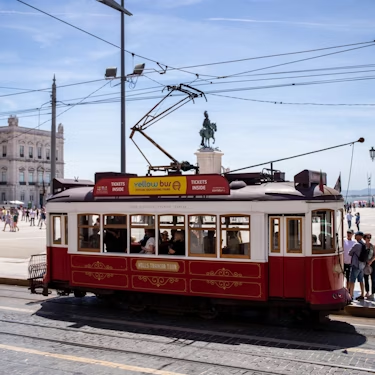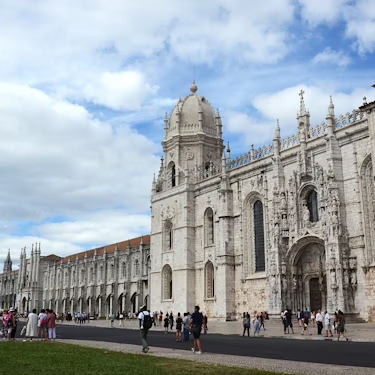More about: Lisbon in 1 Day: everything you need to know
Lisbon is a city with a lot to see and do. But you won't always be lucky enough to have several days to visit it. If you only have 24 hours to get to know the Portuguese capital, don't worry. If you organise yourself well , you can visit the most important monuments in just one day.
Start the day with the best views: The Portas do Sol viewpoint in Alfama
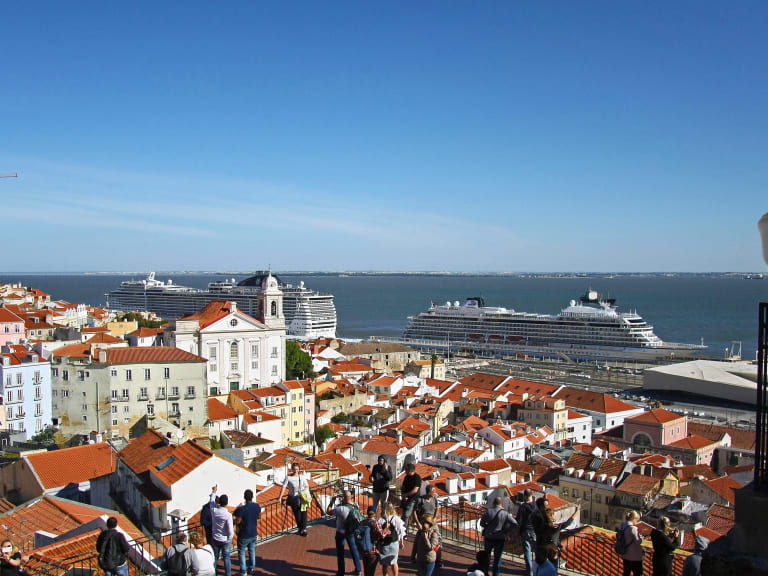
Lisbon is known as "the city of seven hills". The city itself grows around them. Thanks to this orography we have the possibility of contemplating several panoramic views of the whole city. The best view, in my opinion, is offered by the Portas do Sol viewpoint. Nearby there are several terraces where you can have a good breakfast while you enjoy the views and recharge your batteries to start the day
Another way to get to know the basics of Lisbon is by taking a guided tour, some of them offer you the best things to see and do in the city centre. Just be aware of the times and check the itinerary of each tour beforehand so you don't miss anything.
Stroll through the historic Alfama district

Both the Portas do Sol and Santa Lucia viewpoints are located in Alfama, a neighbourhood that grows in the east of Lisbon on the slopes of the hill below St. George's Castle, and a stroll through its streets is a must in the Portuguese capital. If you don't want to miss a thing, you have the option of booking a guided tour of the Alfama neighbourhood.
Enjoy the architecture and admire some of its monuments such as St. George's Castle or the National Pantheon. Unfortunately, as you only have 24 hours, you won't be able to stop to visit the inside of these two and many other places. But the views outside and the promenade are attractive enough to enjoy the area.
Admire the Lisbon Cathedral

Of all the monuments in the Alfama district, there is one that stands out above the rest and deserves a more leisurely visit. This is the Lisbon Cathedral, known as the Sé Cathedral.
It is one of the oldest buildings in Lisbon, as it is one of the few that has survived the numerous earthquakes and fires that have ravaged the city throughout its history. Romanesque in style, it houses the remains of Lisbon's patron saint, St. Vincent, as well as a beautiful cloister and a treasure of great value. It can be visited free of charge and for an extra €2.5 you can add the cloister and the treasure to your visit.
Take the Santa Justa elevator and visit Rua Augusta

After visiting the Cathedral head to **Lisbon'**s historic centre. There is plenty to see here, but prioritise one of the city's most famous landmarks, the Elevador de Santa Justa. Located on the street of the same name, about 20 minutes from the Cathedral, this particular lift links the Baixa Pombalina and Chiado neighbourhoods. It is 45 metres high, which also gives you a good view of the centre of Lisbon.
If you are on time, near this point you will find the ruins of the Convento do Carmo and the Plaza de Pedro IV, two places worth visiting, but only if the clock allows you to do so. Next to it is Rua Augusta, the main artery of the Baixa district in the heart of Lisbon. It is a long pedestrian street that is home to a myriad of shops and restaurants.
Walk around the Praça do Comércio

The historic Praça do Comércio is accessed through the Arco da Rua Augusta and leads to an expanse crowned at its centre by the equestrian statue of José I and leading directly to the banks of the Tagus River.
Here you can go up to the Mirador do Arco and contemplate its architecture, take a photograph of the equestrian statue of José I and go to the Cais das Colunas pier on the banks of the Tagus. This square is also a hub for transport, both maritime and tram.
Stop for lunch

If the morning has gone smoothly, you will arrive at the Praça do Comércio at midday and it is time to stop for lunch. At this point you have several options:
- Find a restaurant near the square.
- Take a tourist tram to the Belém neighbourhood and have lunch there.
- Take a gastronomic tour of Lisbon to get to know the local products and make the most of your lunch.
My advice is to first eat in a restaurant near the square to recharge your batteries and then take a tram to the Belém neighbourhood in time for dessert. The trip from Praça do Comércio to Belém takes 20 minutes and, once there, you can look for a pastry shop to try the typical Belém pastries with a coffee.
Lisbon is a city with a strong gastronomic tradition. There are plenty of gastronomic tours in Lisbon and wine tastings that can be done all over the Portuguese capital
Visit the Belém neighbourhood

To get to the Belém neighbourhood from Praça do Comércio, just take the tram line 15. The journey takes just 20 minutes. Technically, Belém is not a neighbourhood of Lisbon, but a city that has been annexed to the capital. It is, therefore, about 7 kilometres from the centre, but is home to many of Lisbon's most important sights.
The Jerónimos Monastery or the Belém Tower, two of the most representative symbols of Lisbon are located in this area. This area was one of the least affected by the 1755 earthquake that severely affected many parts of the city and, for this reason, its monuments are better preserved. Its origins date back to the 16th century, coinciding with the era of the conquistadors, which greatly influences the character of its buildings.
Discover a world heritage building: the Jerónimos Monastery

This building was born out of the golden age of the great explorers, who brought a wealth of riches to the Portuguese capital and built the monastery as a sign of grandeur. Such was the investment that it took more than 100 years to build it. Its façade, the interior of the church and its cloister are the highlights of this World Heritage Site since 1983.
It is not only the most visited monument in Lisbon, but also in the whole of Portugal, so I recommend you book your tickets in advance It is open every day of the week except Mondays. It is a must-see if you are travelling to Lisbon.
Don't miss the Monument to the Discoveries

Leaving the Jerónimos Monastery and very close to the Tagus coast you will find the Padrão dos Descobrimentos Monument or the Monument to the Discoveries. If you want to get to know it in depth, don't hesitate to book a tour of the Belém neighbourhood
This spectacular 52-metre high construction was erected in 1960 to commemorate the 500th anniversary of the death of Henry the Navigator and as a tribute to all the adventurers and discoverers who marked the history of Portugal.
The very ground on which the building stands is also part of the ensemble, as it depicts a map of the world with the voyages and expeditions of the most famous explorers who set out from Portugal. Located on the banks of the Tagus, this monument deserves a few minutes to contemplate before approaching the last stop on our itinerary.
End the day at the Belém Tower
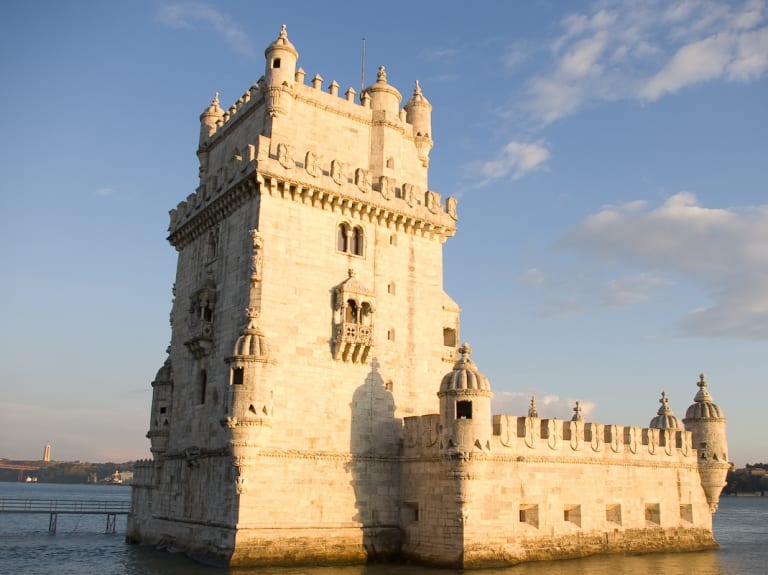
To end our day in Lisbon we will visit another of the main symbols of the city, the Belém Tower. Despite its apparent simplicity, this small fort was also declared a World Heritage Site. It is a contemporary of the Jerónimos Monastery and was commissioned by King Manuel I to serve as a fort and lighthouse.
Although at first glance it is not very imposing due to its size, its charm lies in its shape and small details. It is when we look at its decoration that we appreciate the tower's charm. If you have time to spare, you can go inside to enjoy the views of the Tagus and the Belém district.
To do this, don't forget to book your tickets for the Belém Tower in advance to make the most of the day and the visit. This is the ideal place to end our day trip to Lisbon.
Tips for visiting Lisbon in one day
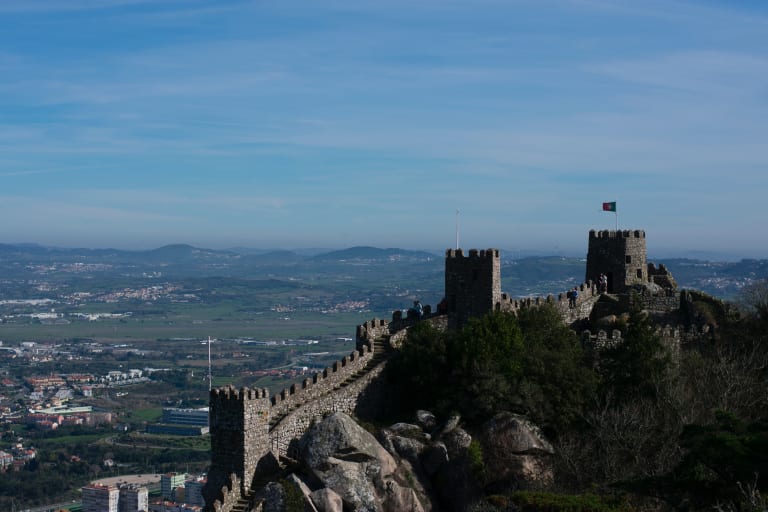
To make the most of your 24-hour visit to Lisbon, here are some tips that you may find useful:
- Much of the itinerary is on foot along steep cobbled streets, so choosing good footwear is of vital importance.
- Don't let the sheets stick to you. In this scenario it is best to start the day at first light. This way the views from the viewpoints in the Alfama district are more beautiful and you will have less difficulty finding a good spot on a terrace for breakfast.
- Lisbon is a city with a long gastronomic tradition. There are good value-for-money restaurants near the Praça do Comércio, as well as in the streets between the Santa Justa elevator and Praça do Comércio. Da Prata 52 or the Paludarium are two good places.
- Leave room for dessert and when you visit the Belém neighbourhood you can't miss the traditional Belém pastries. They are cream tarts that you can enjoy in any café, but the best ones can be found near the Jerónimos Monastery.
- Among the most visited monuments in Portugal is the Jerónimos Monastery, so book your tickets in advance
- The best way to get from Praça do Comércio to Belém is to book a tram. But you can also book a cruise along the coast along the Tagus, which is a good option if you want to relax.




